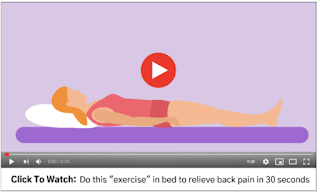Are you struggling with back pain? Is the pain getting bothersome but not severe enough to warrant surgery? Do you want to make your back pain go away?
If you're one of the estimated 80% of Americans who experience back pain at some point in their lives, you know it can be highly debilitating. Back pain can make it difficult to move, work, or even get out of bed.
While there are many treatments for back pain, from medications to surgery, many people are looking for more natural solutions that help to get rid of it for good. Here are the top 5 most effective natural solutions for back pain relief.
1. Ice and Heat Therapy
Sometimes applying heat or cold can help relieve back pain. Ice is excellent for reducing inflammation, while heat helps to relax the muscles and improve blood circulation. This kind of therapy is an effective solution for days when you need some quick relief.
Try putting a heating pad on your back for 20 minutes or soaking in a hot bathtub several times a day. Alternatively, you can place an ice pack on your back for 10-15 minutes a few times a day.
2. Chiropractic Adjustments
Chiropractic adjustments are an excellent way to get relief from back pain. A chiropractor will use their hands to manipulate the spine and other joints in the body. This treatment can help realign the spine, taking pressure off the nerves and muscles causing the pain.
You might feel sore for 24 hours upon receiving treatment, but this should only be temporary. The goal of chiropractic adjustments is to restore your health, not just relieve symptoms.
3. Acupuncture
Acupuncture is another effective natural solution for back pain. This ancient Chinese practice involves inserting thin needles into the skin at specific points.
It is a technique that stimulates sensory nerves and muscles. This process can help to release endorphins, which are natural painkillers.
4. Massage Therapy
Massage therapy is another great way to relieve back pain. A massage therapist will use their hands to knead the muscles and tissues in the back, which helps to loosen up tight muscles and relieve tension.
You can choose various massage types, from the relaxing Swedish Massage (for overall stress relief) to the more targeted Deep Tissue Massage (for ease of painful trouble spots).
5. Yoga and Exercise
Yoga is a terrific way to relieve back pain by stretching and strengthening the muscles in the back. Some specific yoga poses can help ease back pain, such as the Downward-Facing Dog and the Sphinx Pose.
Exercise is vital for overall health but can also help relieve back pain. Low-impact activities like swimming and walking can help to strengthen the muscles in the back.
Make Your Back Pain Go Away
These are just a few of the most effective natural solutions for back pain relief. If you're suffering from back pain, it’s worth considering any of these treatments. Before you begin, talk to your doctor about which options might be right for you.
Meanwhile, yoga and exercise should be part of your daily routine regardless of your health status. But if your back pain is tremendous, check with your doctor if there are any exercises you might want to avoid while treating your back pain.
Follow these tips, and you should start to see a difference in your back pain within a few weeks. Remember to be patient; it may take some time before you see a significant improvement. But if you stick with these treatments, you should eventually be able to say, "back pain go away!" for good.

Commenti
Posta un commento